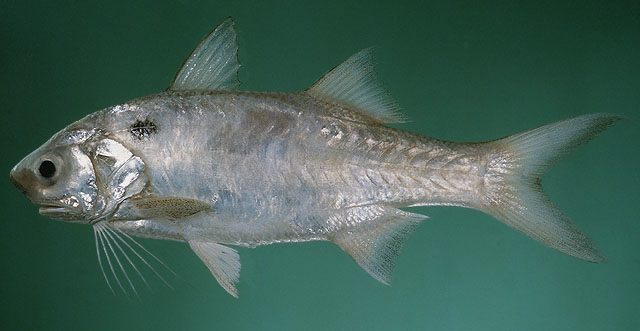| Polynemidae (Threadfins) |
| 30 cm TL (male/unsexed) |
|
demersal; brackish; marine; depth range 16 - 73 m, amphidromous |
| Eastern Indian Ocean and Western Pacific: southwestern India to Papua New Guinea, north to Japan. May rarely occur in the Philippines, eastern Indonesia, and Papua New Guinea (Ref. 57343). Not in Red Sea (Ref. 84159). |
|
Dorsal spines (total): 9-9; Dorsal soft rays (total): 12-13; Anal spines: 3-3; Anal soft rays: 11-13; Vertebrae: 24-24. With 6 pectoral filaments; uppermost not reaching posterior tip of pectoral fin. Pectoral fin, rays moderate, 19-25% of SL; all rays branched except uppermost 1 or 2. Second dorsal spine short, 5-8% of SL. Atrophied swim bladder, like a string. A large black spot anteriorly on lateral line (Ref. 40958, 41110). No upper lip; lower lip well-developed except at symphysis. Operculum broadly rounded; preoperculum coarsely serrated. Color is golden-olive above ,silvery below. A large oval blotch is at the start of the lateral line (Ref. 561). |
| A marine species found on sandy and muddy bottoms of the continental shelf (Ref. 4340, 11230, 57343). Frequently enters estuaries (Ref. 9685, 11230). Feeds mainly on small crustaceans (especially shrimps), fishes and benthic organisms; also on sponges and fish scales (Ref. 9685). The progression in this hermaphrodite is protandrous, changing from a juvenile to a hermaphrodite, then a female (Ref. 9685). |
|
Not Evaluated (N.E.) Ref. (130435)
|
| harmless |
Source and more info: www.fishbase.org. For personal, classroom, and other internal use only. Not for publication.
